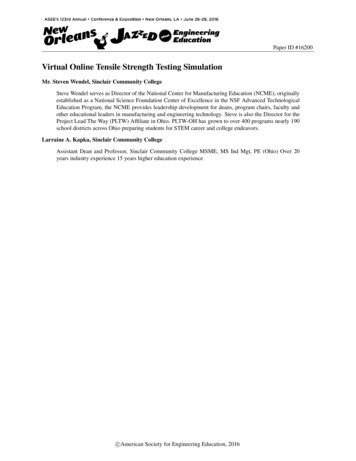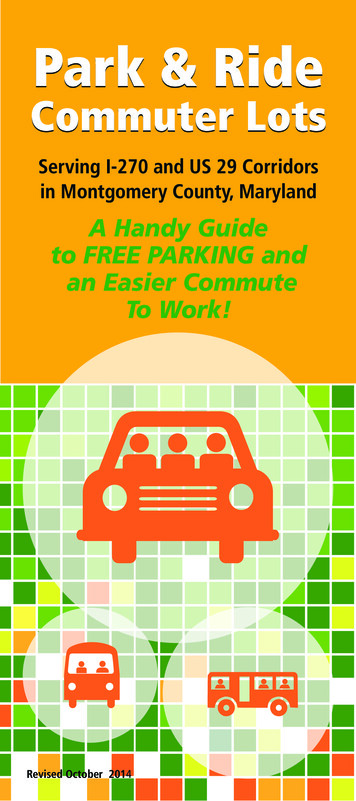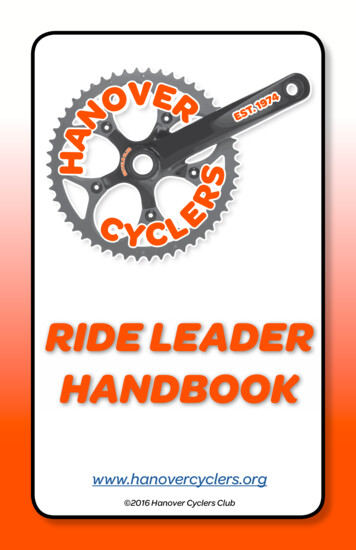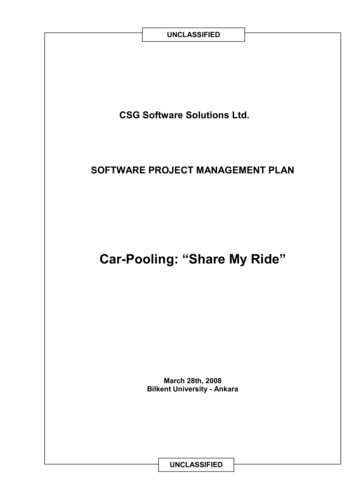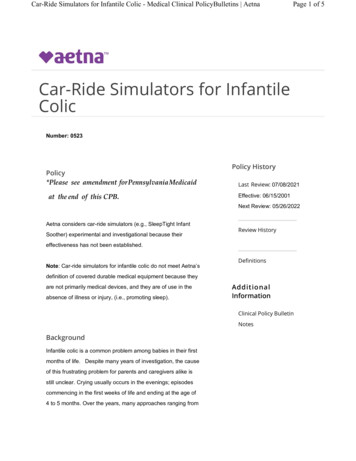
Transcription
Car-Ride Simulators for Infantile Colic - Medical Clinical Policy Bulletins AetnaPage 1 of 5Car-Ride Simulators for InfantileColicNumber: 0523Policy*Please see amendment forPennsylvaniaMedicaidat the end of this CPB.Policy HistoryLast Review: 07/08/2021Effective: 06/15/2001Next Review: 05/26/2022Aetna considers car-ride simulators (e.g., SleepTight InfantSoother) experimental and investigational because theirReview Historyeffectiveness has not been established.Note: Car-ride simulators for infantile colic do not meet Aetna’sDefinitionsdefinition of covered durable medical equipment because theyare not primarily medical devices, and they are of use in theabsence of illness or injury, (i.e., promoting sleep).AdditionalInformationClinical Policy BulletinNotesBackgroundInfantile colic is a common problem among babies in their firstmonths of life. Despite many years of investigation, the causeof this frustrating problem for parents and caregivers alike isstill unclear. Crying usually occurs in the evenings; episodescommencing in the first weeks of life and ending at the age of4 to 5 months. Over the years, many approaches ranging from
Car-Ride Simulators for Infantile Colic - Medical Clinical Policy Bulletins Aetnapharmacotherapy to behavioral methods have been used tomanage infantile colic; however no effective cure has beendemonstrated for this disorder.Currently, the mainstays of treatment of this time-limitedproblem entail parental reassurance and behavioralmanagement. Dietary changes (soy formula), herbal tea, andreduction of stimulation level in the infant's environment havebeen tried with varying degrees of success.Car-ride simulators (e.g., SleepTight Infant Soother, SweetDreams, Inc., Westerville, OH) have also been used to treatinfantile colic. These devices attempt to soothe crying, fussyand colicky babies by vibrating the infant's crib to simulate thesound and motion of a car traveling at 55 miles per hour.Published studies, including a randomized controlled trial(RCT), do not establish the effectiveness of this device; theywere no better than caregiver reassurance and support alonein decreasing daily hours of crying and maternal anxiety.An assessment of interventions for infantile colic concludedthat car-ride simulators are of “unknowneffectiveness” (Lucassen, 2009). The assessment noted that,use of a crib vibrator device may be no more effective thanreassurance, focused advice, and/or infant massage atreducing the duration of crying.In a systematic review, Perry et al (2011) evaluated all RCTsof nutritional supplements and other complementary andalternative medicines as a treatment for infantile colic. Fiveelectronic databases were searched from their inception toFebruary 2010 to identify all relevant RCTs of complementaryand alternative medicines and supplements for infantile colic.Reference lists of retrieved articles were hand searched.Data were extracted by 2 independent reviewers, andmethodological quality was assessed using the Jadad scoreand key aspects of the Cochrane risk of bias. A total of 15RCTs met the inclusion criteria and were included -- 13 studiesPage 2 of 5
Car-Ride Simulators for Infantile Colic - Medical Clinical Policy Bulletins Aetnawere placebo-controlled; 8 were of good methodologicalquality; 11 trials indicated a significant result in favor ofcomplementary and alternative medicines. However, none ofthese RCTs was without flaws. Independent replications weremissing for most modalities. The authors concluded that someencouraging results exist for fennel extract, mixed herbal tea,and sugar solutions, although it has to be stressed that alltrials have major limitations. Thus, the notion that any form ofcomplementary and alternative medicine is effective forinfantile colic currently is not supported from the evidence fromthe included RCTs. The authors concluded that additionalreplications are needed before firm conclusions can be drawn.CPT Codes / HCPCS Codes / ICD-10 CodesInformation in the [brackets] below has been added forclarification purposes. Codes requiring a 7th character arerepresented by " ":CodeCode DescriptionThere are no specific codes for car-ride simulators:ICD-10 codes not covered for indications listed in the CPB:(not all-inclusive):R10.83Colic [infantile]The above policy is based on the followingreferences:1. Garrison MM, Christakis DA. A systematic review oftreatments for infant colic. Pediatrics. 2000;106:184-190.2. Huhtala V, Lehtonen L, Heinonen R, Korvenranta H.Infant massage compared with crib vibrator in thetreatment of colicky infants. Pediatrics. 2000;105(6):E84.Page 3 of 5
Car-Ride Simulators for Infantile Colic - Medical Clinical Policy Bulletins Aetna3. Lucassen PL, Assendelft WJ, Gubbels JW, et al.Effectiveness of treatments for infantile colic: Systematicreview. Br Med J. 1998;316(7144):1563-1569.4. Balon AJ. Management of infantile colic. Am FamPhysician. 1997;55(1):235-242, 245-246.5. Parkin PC, Schwartz CJ, Manuel BA. Randomizedcontrolled trials of three interventions in the managementof persistent crying of infancy. Pediatrics. 1993;92 (2):197201.6. Sosland JM, Christophersen ER. Does SleepTight work?A behavioral analysis of the effectiveness of SleepTightfor the management of infant colic. J Appl Behav Anal.1991;24(1):161-166.7. Barr RG. Crying and colic. In: Rudolph’s Pediatrics. 20thed. AM Rudolph, ed. Stamford, CT: Appleton & Lange;1996:98-100.8. Leung AK, Lemay JF. Infantile colic: A review. J R SocHealth. 2004;124(4):162-166.9. Roberts DM, Ostapchuk M, O'Brien JG. Infantile colic.Am Fam Physician. 2004;70(4):735-740.10. Rogovik AL, Goldman RD. Treating infants' colic. CanFam Physician. 2005;51:1209-1211.11. Lucassen P. Infantile colic. In: BMJ Clinical Evidence.London, UK: BMJ Publishing Group; updated September2009.12. Crotteau CA, Wright ST, Eglash A. Clinical inquiries.What is the best treatment for infants with colic? J FamPract. 2006;55(7):634-636.13. Perry R, Hunt K, Ernst E. Nutritional supplements andother complementary medicines for infantile colic: Asystematic review. Pediatrics. 2011;127(4):720-733.Page 4 of 5
Car-Ride Simulators for Infantile Colic - Medical Clinical Policy Bulletins AetnaPage 5 of 5Copyright Aetna Inc. All rights reserved. Clinical Policy Bulletins are developed by Aetna to assist in administering planbenefits and constitute neither offers of coverage nor medical advice. This Clinical Policy Bulletin contains only a partial,general description of plan or program benefits and does not constitute a contract. Aetna does not provide health careservices and, therefore, cannot guarantee any results or outcomes. Participating providers are independent contractorsin private practice and are neither employees nor agents of Aetna or its affiliates. Treating providers are solelyresponsible for medical advice and treatment of members. This Clinical Policy Bulletin may be updated and therefore issubject to change.Copyright 2001-2021 Aetna Inc.
AETNA BETTER HEALTH OF PENNSYLVANIAAmendment toAetna Clinical Policy Bulletin Number: 0523 Car-RideSimulators for Infantile ColicThere are no amendments for Medicaid.annual 08/01/2021
3. Lucassen PL, Assendelft WJ, Gubbels JW, et al. Effectiveness of treatments for infantile colic: Systematic review. Br Med J. 1998;316(7144):1563-1569.
